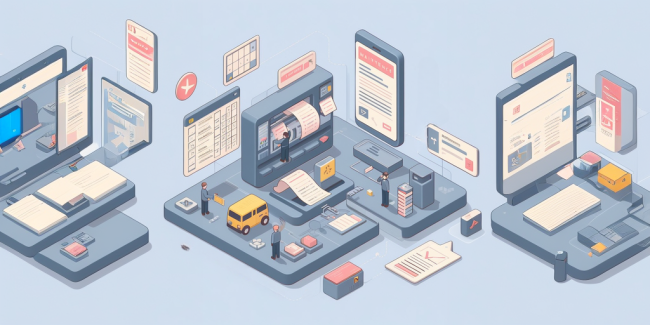Struggling with maintenance requests can be a hassle, but it doesn't have to be. A maintenance ticketing system can be a game-changer as it functions like an adjuvant for your maintenance necessities. By centralizing and simplifying the process, it fosters effective communication, cuts down on wasted time, and alleviates stress. Let's explore the benefits of these systems further.
Overview of Maintenance Ticketing Systems
An efficient workflow is crucial for any organization, more so when handling maintenance issues. Maintenance ticketing systems offer a solution by providing a centralized platform for task tracking and resolution. Tasks are easily submitted, assigned to the suitable workforce, and monitored until completed.
A practical demonstration of how these systems boost efficiency is via automated notifications. Staff receive an alert when a new ticket is created, ensuring prompt response. Additionally, these systems allow for data tracking and analysis, pinpointing areas for future enhancements.
With the help of a maintenance ticketing system, organizations can manage maintenance tasks effectively, leading to increased productivity, decreased idle time, and an enhanced experience for employees and customers alike.
Benefits of Implementing a Maintenance Ticketing System
Improved Workflow Efficiency
One significant advantage of a maintenance ticketing system is the boost it gives to your team's workflow efficiency. Communication becomes efficient, leading to faster response rates and suitable task assignments. Rather than manually assigning tickets to technicians and awaiting updates, the system routes tickets to the right team members while providing real-time status updates. This removal of delays promotes an agile workflow, directly enhancing productivity and customer satisfaction.
Enhanced Communication and Collaboration
Effective communication and collaboration drive the smooth operation of maintenance ticketing systems. By enabling instant transmission of information among team members, tasks are swiftly assigned and addressed, minimizing idle time. Collaboration features such as document sharing and commenting simplify troubleshooting, enabling technicians to share ideas and expertise seamlessly.
A technician might share an issue-specific photo, enabling colleagues to grasp the problem swiftly and suggest solutions. Integrations with commonly used messaging tools further smooth out interdepartmental communication, ensuring efficacious collaboration and problem-solving.
Increased Accountability and Transparency
Implementing a maintenance ticketing system also brings enhanced accountability and transparency. Such a system allows for the tracking and observation of all maintenance tasks, preventing any task from being overlooked. Companies can easily assign tasks, set timelines, and monitor progress through a centralized platform, thus holding employees accountable and providing management with a clear view of the maintenance mechanisms.
Managers can examine the status of each ticket, pinpoint bottlenecks, and make informed decisions regarding the allocation of resources.
Improved Data Analysis and Reporting
A notable advantage of maintenance ticketing systems is their ability to augment data analysis and reporting. The provided insights can guide organizations in making data-driven decisions. For instance:
Analyzing the average resolution time of maintenance tickets allows for the identification of areas that could use improvement.
Detailed reporting enables an assessment of the maintenance team's overall performance, identifying trends that can boost efficiency.
Frequent equipment failures can be pinpointed using data analysis, ensuring proactive problem-solving and reduced downtime.
With more robust data analysis and reporting, businesses can streamline their maintenance operations, leading to increased productivity and significant cost savings.
Cost and Time Savings
Significant cost and time savings are among the notable advantages of using a maintenance ticketing system. Streamlining the submission and tracking of maintenance requests reduces the administrative load associated with manual methods. This not only frees up resources but increases overall operational efficiency. Automated ticketing systems provide analytics and reporting, enabling businesses to identify trends and allocate resources efficiently.
The time saved directly translates into increased productivity and lower operational costs.
Example of Successful Implementation of a Maintenance Ticketing System
A manufacturing company serves as an illustration of a successful implementation. With efficient tracking and managing of maintenance requests, the company was capable of swiftly dealing with equipment malfunctions and scheduling repairs promptly. This led to enhanced productivity and minimal disruptions to production schedules. Better synchronization between maintenance staff and other departments was also achieved, improving overall intra-organization communication and collaboration.
Wrapping up
In conclusion, a maintenance ticketing system offers several advantages. Firstly, it facilitates the efficient management and prioritization of maintenance issues by categorizing tickets and tracking issues. This approach results in rapid responses and improved customer satisfaction, which can lead to more streamlined maintenance request processes.
Secondly, it allows managers to monitor the status, response times, and recurring problems effectively. The data accumulated gives valuable insights for making informed decisions and optimizing procedures.
Additionally, by fostering efficient data exchanges, updates, and documentation between technicians and support staff, better teamwork and problem-solving are achieved. Each participant is kept in the loop.
In particular, if you own a facility management business, maintenance ticketing systems can be used as facility maintenance software.
Such a system simplifies report generation and record-keeping by storing comprehensive records of all maintenance activities, solutions applied, and response times. This not only helps in historical data tracking for audits but also assists in future troubleshooting.
Lastly, workflow is streamlined as processes such as ticket assignment, notification, and report generation are automated. The system's benefits cumulatively improve efficiency, customer satisfaction, communication, and documentation.
